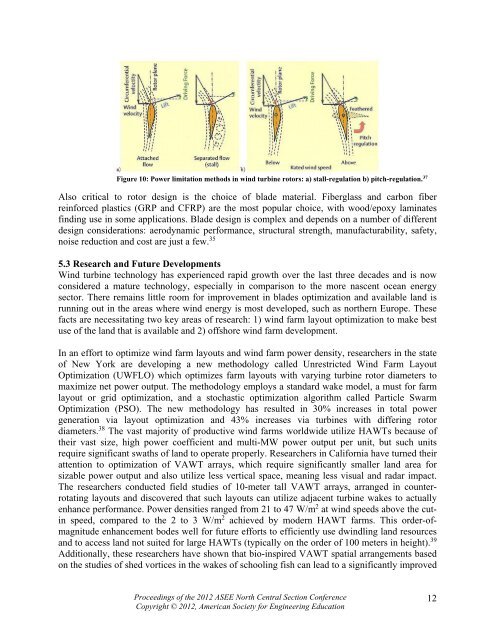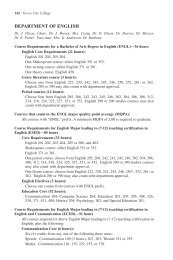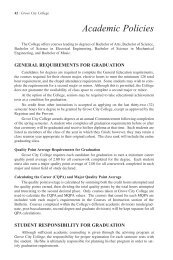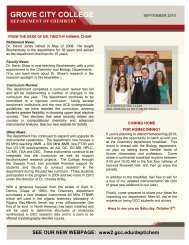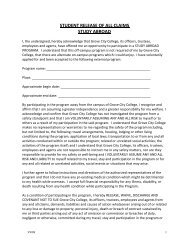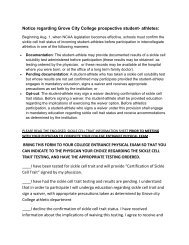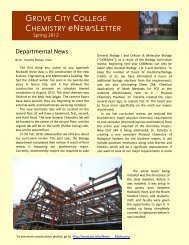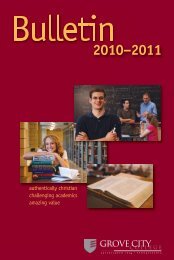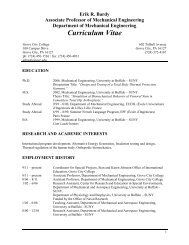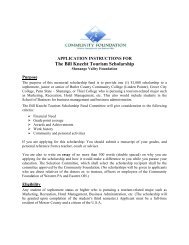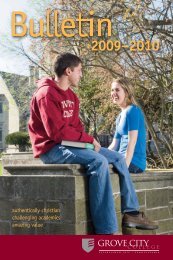A Review of Power-Generating Turbomachines - Grove City College
A Review of Power-Generating Turbomachines - Grove City College
A Review of Power-Generating Turbomachines - Grove City College
Create successful ePaper yourself
Turn your PDF publications into a flip-book with our unique Google optimized e-Paper software.
Figure 10: <strong>Power</strong> limitation methods in wind turbine rotors: a) stall-regulation b) pitch-regulation. 37<br />
Also critical to rotor design is the choice <strong>of</strong> blade material. Fiberglass and carbon fiber<br />
reinforced plastics (GRP and CFRP) are the most popular choice, with wood/epoxy laminates<br />
finding use in some applications. Blade design is complex and depends on a number <strong>of</strong> different<br />
design considerations: aerodynamic performance, structural strength, manufacturability, safety,<br />
noise reduction and cost are just a few. 35<br />
5.3 Research and Future Developments<br />
Wind turbine technology has experienced rapid growth over the last three decades and is now<br />
considered a mature technology, especially in comparison to the more nascent ocean energy<br />
sector. There remains little room for improvement in blades optimization and available land is<br />
running out in the areas where wind energy is most developed, such as northern Europe. These<br />
facts are necessitating two key areas <strong>of</strong> research: 1) wind farm layout optimization to make best<br />
use <strong>of</strong> the land that is available and 2) <strong>of</strong>fshore wind farm development.<br />
In an effort to optimize wind farm layouts and wind farm power density, researchers in the state<br />
<strong>of</strong> New York are developing a new methodology called Unrestricted Wind Farm Layout<br />
Optimization (UWFLO) which optimizes farm layouts with varying turbine rotor diameters to<br />
maximize net power output. The methodology employs a standard wake model, a must for farm<br />
layout or grid optimization, and a stochastic optimization algorithm called Particle Swarm<br />
Optimization (PSO). The new methodology has resulted in 30% increases in total power<br />
generation via layout optimization and 43% increases via turbines with differing rotor<br />
diameters. 38 The vast majority <strong>of</strong> productive wind farms worldwide utilize HAWTs because <strong>of</strong><br />
their vast size, high power coefficient and multi-MW power output per unit, but such units<br />
require significant swaths <strong>of</strong> land to operate properly. Researchers in California have turned their<br />
attention to optimization <strong>of</strong> VAWT arrays, which require significantly smaller land area for<br />
sizable power output and also utilize less vertical space, meaning less visual and radar impact.<br />
The researchers conducted field studies <strong>of</strong> 10-meter tall VAWT arrays, arranged in counterrotating<br />
layouts and discovered that such layouts can utilize adjacent turbine wakes to actually<br />
enhance performance. <strong>Power</strong> densities ranged from 21 to 47 W/m 2 at wind speeds above the cutin<br />
speed, compared to the 2 to 3 W/m 2 achieved by modern HAWT farms. This order-<strong>of</strong>magnitude<br />
enhancement bodes well for future efforts to efficiently use dwindling land resources<br />
and to access land not suited for large HAWTs (typically on the order <strong>of</strong> 100 meters in height). 39<br />
Additionally, these researchers have shown that bio-inspired VAWT spatial arrangements based<br />
on the studies <strong>of</strong> shed vortices in the wakes <strong>of</strong> schooling fish can lead to a significantly improved<br />
Proceedings <strong>of</strong> the 2012 ASEE North Central Section Conference<br />
Copyright © 2012, American Society for Engineering Education<br />
12


